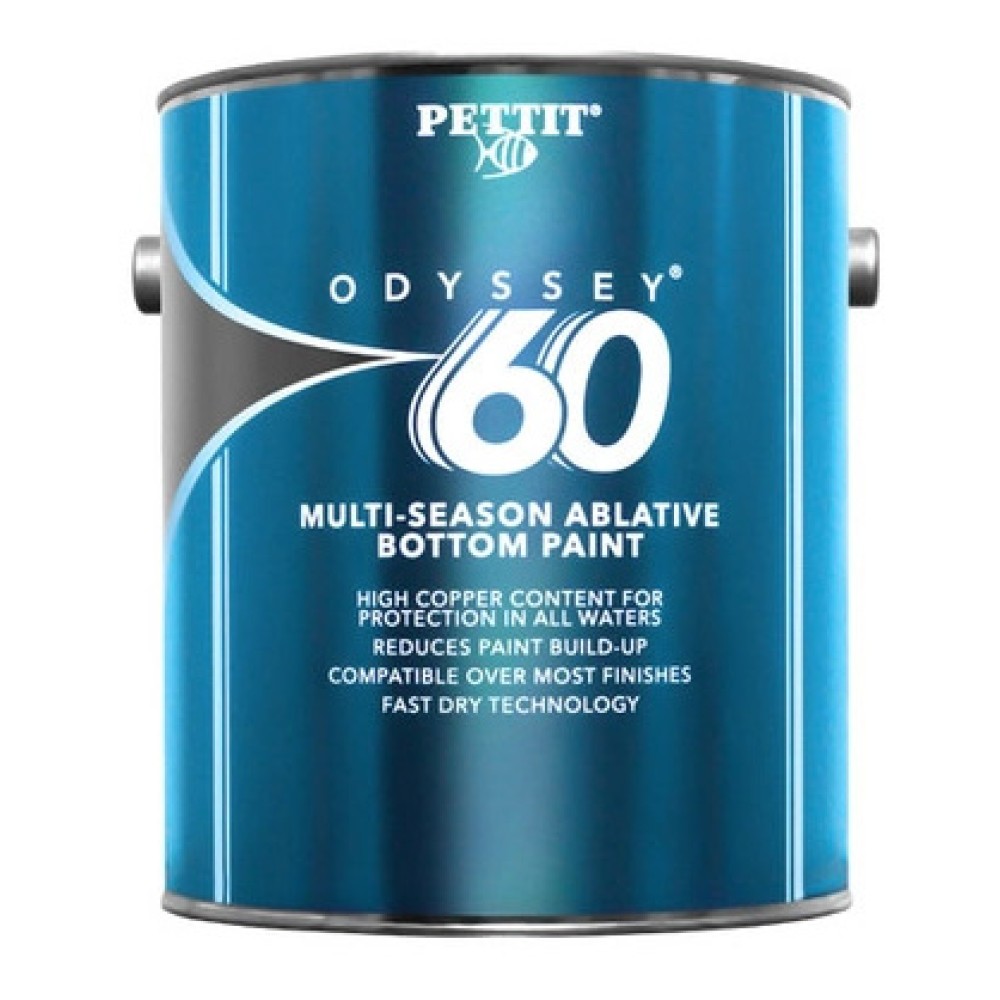APPLICATION INFORMATION
APPLICATION SYSTEMS: Odyssey 60 is easily applied by brush, roller or spray. When rolling use only a high-quality short nap (maximum 3/16” nap) roller cover. Apply using thin coats; over-application of this product will virtually assure inadequate coating performance. Mix paint thoroughly to ensure toxicants are evenly dispersed throughout the can. All surfaces must be clean, dry and properly prepared prior to painting. Do not apply Odyssey 60 on aluminum hulls or outdrives.
PREVIOUSLY PAINTED SURFACES: If the previous coating is in good condition, thoroughly sand with 80 grit paper then solvent clean with 120 Brushing Thinner to remove residue. Apply two finish coats of Odyssey 60. If the previous coating is soft or in poor condition, remove to the bare surface by sanding or using EZ Speed Strip™ 125. Proceed with appropriate bare system as described below.
BARE FIBERGLASS: All bare fiberglass, regardless of age, should be thoroughly cleaned with 92 Bio-Blue® Hull Surface Prep or de-waxed several times with Pettit D-95 Dewaxer. SANDING METHOD: Sand the hull thoroughly with 80-grit sandpaper to a dull, frosty finish and rewash the sanded surface with 120 Brushing Thinner to remove sanding residue. Then apply two or three thin coats of this product, following application instructions. Careful observation of application instructions will help ensure long-term adhesion of this and subsequent years’ antifouling paint.
TO ELIMINATE THE SANDING OPERATION: Thoroughly clean, de-wax and etch the surface with 92 Bio-Blue Hull Surface Prep using a course Scotch-Brite® pad. Thoroughly rinse all residue from surface and let dry. Then apply one coat of Pettit Protect® High Build Epoxy Primer. Consult the primer label for complete application and antifouling top coating instructions. Apply two or three thin coats of this product.
KEELS – STEEL OR CAST IRON: Abrade surface to bright metal; clean off residue. Apply one coat of 6980 Rustlok® Steel Primer, allowing to dry only 1-2 hours prior to over coating with one coat of 4700/4701 High Build Epoxy Primer. Then, if fairing is required, apply 7050 EZ Fair Epoxy Fairing Compound followed by one additional coat of 4700/4701 High Build Epoxy Primer, finish with two or three coats of this product.
BARRIER COAT: Fiberglass bottoms potentially can form osmotic blisters within the gelcoat and into the laminate. To render the bottom as water impermeable as possible, prepare the fiberglass surface as mentioned above (sanding method) then apply two to three coats of Pettit-Protect 4700/4701 Gray High Build Epoxy Primer or three coats of Pettit Protect 4100/4101 White High Build Epoxy Primer per label directions. Apply two or three thin coats of this product. See Technical Bulletin TB-1000 for detailed instructions.
BLISTERED FIBERGLASS: See Pettit Technical Bulletin TB-1000 Gelcoat Blister Repair and Prevention Specification for detailed instructions.
BARE WOOD: Bare wooden hulls should be sanded thoroughly with 80-grit sandpaper and wiped clean of sanding residue with 120 Brushing Thinner. A coat of 6627 Tie-Coat Primer thinned 25% with 97 Epoxy Thinner should be applied directly to the bare wood. Allow drying 4 hours and then applying two un�thinned coats of Odyssey 60 per instructions. Existing, hard antifouling paint should be thoroughly sanded. If priming is necessary on bare wood spots, apply a touch-up coat of 6627 Tie-Coat Primer thinned 25% with 97 Epoxy Thinner to these areas. Then apply the subsequent coats of this product.
STEEL HULLS: To remove loose rust and scale from the metal surface, scrape, sandblast or wire brush. Solvent clean the surface to remove grease and dirt then apply one or two coats of Pettit 6980 Rustlok Primer* followed by two coats of Pettit 4700/4701 High Build Epoxy Primer. Follow with this product.
MAINTENANCE: No antifouling paint can be effective under all conditions of exposure. Man-made pollution and natural occurrences can adversely affect antifouling paint performance. Extreme hot and cold-water temperatures; silt, dirt, oil, brackish water and even electrolysis can ruin an antifouling paint. Therefore, we strongly suggest that the bottom of the boat be checked regularly to make sure it is clean and that no growth is occurring. Lightly clean the bottom with a sponge or cloth to remove anything from the antifouling paint surface. Cleaning is particularly important with boats that are idle for extended period of time.
PHYSICAL DATA
FINISH: Flat
Available Colors: Blue 1265, Green 1365, Red 1665, and Black 1865
COMPONENTS: 1
CURING MECHANISM: Solvent Release
SOLIDS (theoretical):
By weight...84 +/- 2%
By volume...54 +/- 2%
COVERAGE: 440 sq. ft/gal.
VOC: 370 g/l max. (as supplied)
FLASH POINT...73°F (SETA)
APPLICATION DATA
METHOD: Brush, Roller, Airless or Conventional Spray. When applying by roller use a short nap (3/16 inch maximum) roller cover.
NUMBER OF COATS: 2 minimum
DRY FILM THICKNESS PER COAT: 2 mils (3.6 wet mils)
APPLICATION TEMP: 50° F. Min. / 90°F. Max.
DRY TIME* (HOURS):
To Recoat To Launch
90°F 3 8
70°F 6 16
50°F 12 48
THINNER:
120 Brushing thinner


